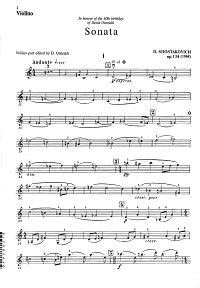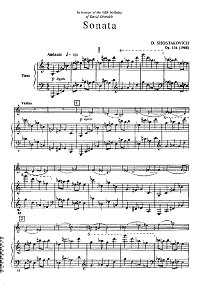Shostakovich - Violin Sonata op.134 (1968)
Shostakovich - Violin Sonata op.134 (1968). You can download the PDF sheet music Shostakovich - Violin Sonata op.134 (1968) on this page. This sonata is firmly tonal even though the 12-note series is present. The Andante opens with the piano tracing a 12-note idea which it then inverts. Over the next statement of the series, the violin enters with a counter idea, the outline of which is a reference to the opening theme of the second Violin Concerto,. and a little later the two partners exchange these ideas. Incidentally, we should add that the piano writing throughout this movement is generally speaking of the barest simplicity and is often a line doubled two octaves apart or open chords.
To download PDF, click the "Download PDF" button below the appropriate sheet music image.
To view the first page of Shostakovich - Violin Sonata op.134 (1968) click the music sheet image. |
| PDF format sheet music |
|
|
|
Violin part: 23 pages. 5453 K
|
Piano part: 58 pages. 10789 K
|
 |
 |
|
|
| Download PDF (14.99
€) |
Download PDF (14.99
€) |
|
|
|
|
There is a contrasting idea a gently skittish idea on the piano with a rhythmic accompaniment in the violin, which the latter subsequently takes up when the roles are reversed. The music occupies itself with this material and the ideas arising naturally from it until we are returned to the opening series. Now the two players re-examine the material in greater detail during the rest of the movement which performs the function of both development and restatement. The middle movement is full of the explosive energy and impetus of many of Shostakovich's scherzos. Its opening tag bears a resemblance to the Twelfth Symphony. The movement as a whole is as brilliant as any of his scherzos and is splendidly sustained. The last movement is in some ways the most impressive of the three and as is the case with the First Violin Concerto or the Piano Trio, is a passacaglia. The theme is prefaced by eight bars in which a 12-note series is divided between the violin on its от, pizzicato, and the left hand of the piano. At the fifth statement of the theme the violin inverts the intervals and later on elements of the introductory series are also heard.
Shostakovich composed two concertos for the violin, one not long after the end of the second world war and the other in the 1960s but despite his long friendship with David Oistrakh, he composed no sonata for the instrument until the present work. It comes immediately after the Twelfth String Quartet (1968) and before the Fourteenth Symphony (1969) and was written in honour of Oistrakh's sixtieth birthday. (Both of the concertos are dedicated to him.) The Sonata is as distinctive in personality as all his later music and has much of its austerity. Because most facets of Shostakovich's personality are already familiar from his earlier work, there is a tendency to assume that some of his later music from the 1960s does little more than chart ground that he has already explored. This is one of the inherent dangers of confusing manner with matter: a third-rate composer unsure of the validity of his own experience is much more in need of a new-sounding stylistic apparatus to disguise the absence of real growth. Shostakovich's depths (and shallows for that matter) are not always immediately discernible: the very consistency of his musical language can be deceptive and blind us to the development that is independent of appearances.
|
|